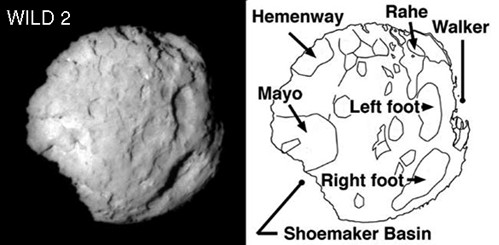Stardust Mission
Space mission to study CometConglomeration of frozen water and gases (methane, ammonia, CO2) and silicates that that formed in the outer solar system and orbits the Sun. In recent years, the description of comets has shifted from dirty snowballs to snowy dirtballs with more dust than ice. However, the ratio is less than 10-to-1. Click on Term to Read More Wild 2 (see
http://stardust.jpl.nasa.gov/home/index.html). During the encounter, Stardust performed a variety of tasks including making counts of particles encountered by the spacecraft and real-time analyses of the compositions of these particles and volatiles. It also captured cometary particles using AerogelSilicon-based solid with a porous, sponge-like structure in which 99.8% of the volume is empty space. Aerogel is used to collect high velocity particles without damaging them and also is used to insulate the electronics of the Mars rovers. Aerogel is 1,000 times less dense than glass and has many Click on Term to Read More and stored them for return to Earth. Results indicate that comets are not composed entirely of volatileSubstances which have a tendency to enter the gas phase relatively easily (by evaporation, addition of heat, etc.). rich materials but rather are a mixture of materials formed at all temperature ranges, at places very near the early sunOur parent star. The structure of Sun's interior is the result of the hydrostatic equilibrium between gravity and the pressure of the gas. The interior consists of three shells: the core, radiative region, and convective region. Image source: http://eclipse99.nasa.gov/pages/SunActiv.html. The core is the hot, dense central region in which the (olivineGroup of silicate minerals, (Mg,Fe)2SiO4, with the compositional endpoints of forsterite (Mg2SiO4) and fayalite (Fe2SiO4). Olivine is commonly found in all chondrites within both the matrix and chondrules, achondrites including most primitive achondrites and some evolved achondrites, in pallasites as large yellow-green crystals (brown when terrestrialized), in the silicate portion Click on Term to Read More) and at places very remote from it (ices).

Image source: http://stardust.jpl.nasa.gov/photo/wild2.html.






